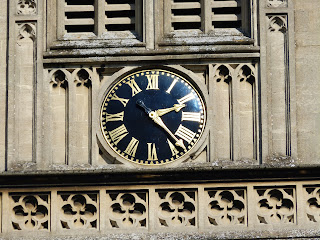As is usual, we start at the railway station. The railway came relatively early to Bath, as part of the legendary Isambard Kingdom Brunel's Great Western Railway. The station dates from 1840.
The clock is simplicity itself, with a plain blue face and only the numerals as marks. Being bath, these are of course Roman numerals.
There is also a modern clock by one of the gatelines within the station:
Close by is the church of St John the Evangelist, which was built in exactly two years between October 1861 and October 1863.
The design is by Charles Hansom, architect of 50 Catholic churches, although its grandeur is somewhat muted by the large surface car park in front of it.
Its proximity to the railway station has some significance. The church's website (www.stjohnsrcbath.org.uk) notes that the clock installed in 1868 was a reliable timepiece, and that "it was reputed to have been used to dispatch the trains in the days before the station was enlarged". Just out of interest, my GWR train from Bath later in the day was 14 minutes late. (Although, having said that, the clock was an hour out).
I was visiting Bath to see the George Shaw exhibition at the Holburne Museum. My route to the museum took me past two other clocks - firstly this one at Bath Cricket Club on North Parade Road:
And secondly at the church of St Mary the Virgin on Darlington Street, dating from 1820.
This has been a religious site since the 10th century, but as the plaque says, the current building was rebuilt in 1777, with the tower added later in 1790. It is also the church where Jane Austen's parents were married, which excites some people.
I was beginning to get the feel that the majority of clocks would be on churches. Bath is a sort of preserved in aspic kind of place - I know I shouldn't really say this, but to me this makes the place somewhat boring as there is less variety in architectural styles, and certainly one dominating colour of building material. Planning restrictions must be draconian. I was therefore resigning myself to reporting on the railway station and a few churches. But lo, there was The Old Post Office.
From a distance in the strong light it looked like there was only a dilapidated dial remaining, but closer inspection reveals that the hands are still there.
The clock bears the name E Routley of Bath. I believe this is Edwin Routley, but I have no further information on this clockmaker.
Back to churches, and the big one - the Abbey. Founded in the 7th century, the current building dates from 1616 (ish - as usual, all sorts of rebuildings and other goings on), with a major restoration by Sir George Gilbert Scott in the 1860s.
The clock dates from 1888, and is by Potts of Leeds. It cost £240 at the time.
Just time before my train to put across the River Avon to St Thomas and St Matt's on Widcombe Hill.
And finally, I returned to Bath in the evening for a book talk / signing (Lotharingia by Simon Winder, since you ask). Night time with just my phone, I have poorly captured this clock on Argyll Street.
And this is the Neptune restaurant in Beehive Yard - if you look hard you can just se the clock.
Ant that's Bath.






























































No comments:
Post a Comment